
PU Prime App
Exclusive deals on mobile



PU Prime App
Exclusive deals on mobile


Hold The Global Markets In Your Hands
Our trading mobile app is compatible with most smart devices. Download the App now and start trading with PU Prime on any device, anytime and anywhere.

The Swing trading strategy is a popular trading method that aims to capture short- to medium-term price movements in the financial markets. Some of the reasons why traders choose to use swing trading strategies include the capability of generating more frequent profits from shorter-term price fluctuations within a broader market trend, and the flexibility when it comes to trade duration.
In this comprehensive guide talking about what is swing trading for beginners, we will delve into some of the best swing trading strategies that can help traders make informed trading decisions and potentially achieve profitability.
Before deep diving into the different swing trading strategies, understanding “what is swing trading” is important. A swing trading strategy involves taking advantage of market swings, both upward and downward, to generate profits. Unlike day trading, which involves quick trades within a single day, swing trading typically holds positions for a few days to several weeks.
Here are some of the most commonly used swing trading strategies suitable for beginner swing traders:
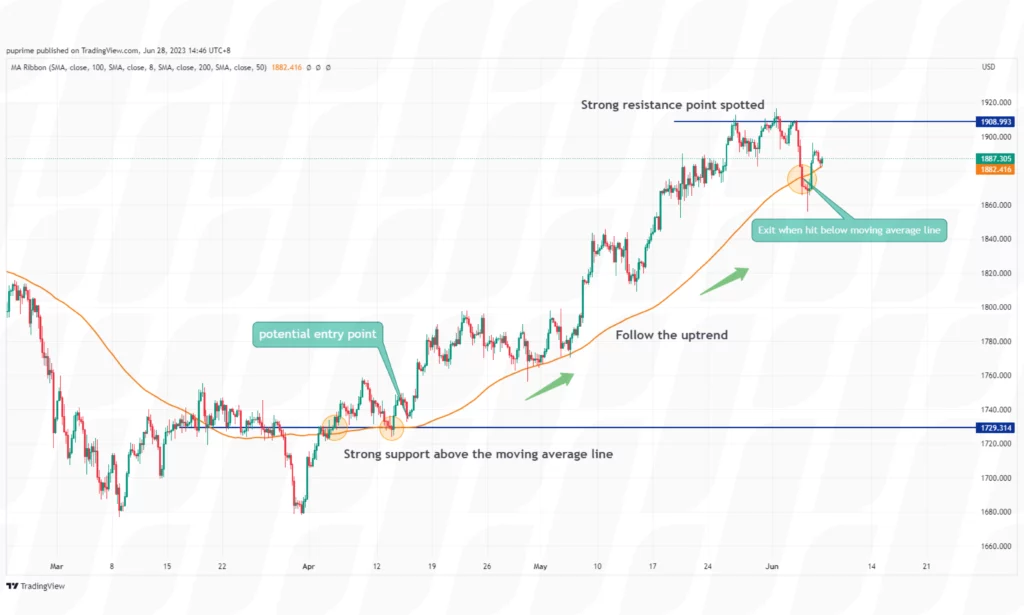
One of the best swing trading strategies is the trend following strategy. Swing traders often incorporate trend trading techniques into their trading strategies to help them identify and capitalize on prevailing market trends. Here’s how swing traders use trend trading to enhance their swing trading approach:
Identifying Trends: Swing traders focus on identifying trends in the market, whether they are upward (uptrend) or downward (downtrend) movements. Swing traders use various technical analysis tools and indicators to identify the presence of a market trend. This includes analyzing price charts, trendlines, moving averages, and other trend-following indicators. By studying price patterns and the behavior of key technical indicators, swing traders can better understand the overall direction of the market and identify potential trading opportunities.
Confirming Trend Direction: Once a potential trend is identified, swing traders seek confirmation of its direction. They use additional technical indicators like volume or momentum indicators, or tools to validate the presence of the trend. Once a trend is confirmed, swing traders look for optimal entry and exit points within the trend. They aim to enter trades at favorable price levels, maximizing the potential for profit. This often involves waiting for price retracements or pullbacks within the trend to find more favorable entry points. Swing traders may also use indicators or chart patterns to time their entries and exits effectively.
Riding the Trend: Once a swing trader enters a trade in the direction of the trend, their objective is to ride the trend for a significant portion of its duration to capture the bulk of the price movement within the trend, maximising their profit potential. Swing traders may employ various techniques such as trailing stops, which allow them to lock in profits as the trend develops and protect against abrupt reversals.
Adapting to Changing Trends: Swing traders understand that trends can change or lose momentum over time. If a trend shows signs of weakness or reversal, swing traders may exit their positions or adjust their stop-loss orders to protect profits or limit losses. They remain flexible and open to new trend opportunities that may arise in different markets or timeframes.
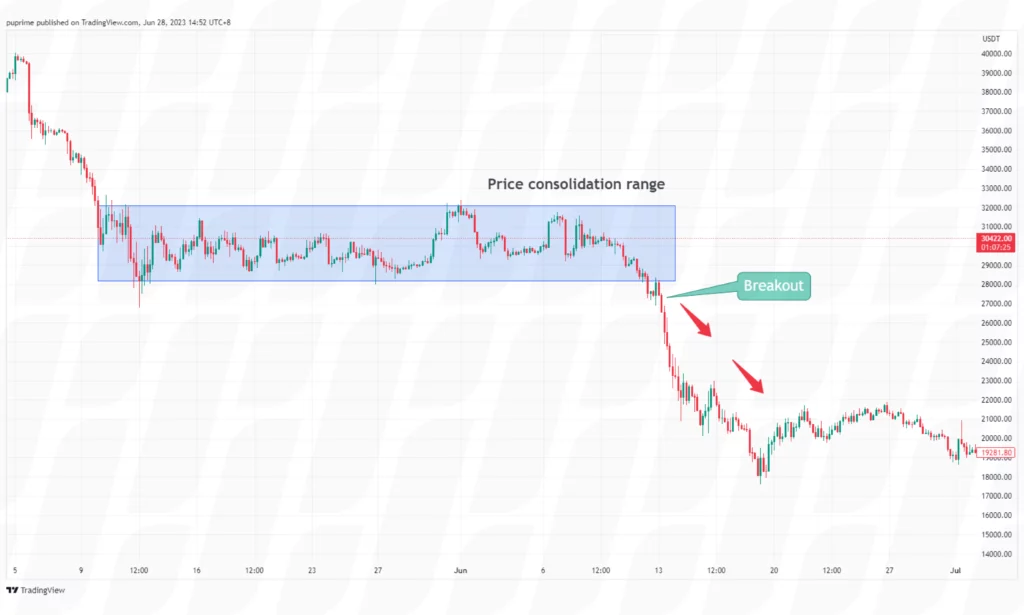
This type of swing trading strategy focuses on identifying price breakouts from well-defined support or resistance levels. Breakout trading is a strategy that swing traders often use to identify and capitalise on significant price movements that occur when an asset’s price breaks through a well-defined level of support or resistance. Here’s how swing traders use breakout trading to enhance their swing trading strategies:
Identifying Breakout Candidates: Swing traders scan the market for financial assets that are exhibiting consolidation patterns, such as triangles, rectangles, or channels. These patterns represent periods of indecision and range-bound trading, and swing traders identify these patterns as potential breakout candidates.
Setting Entry and Exit Criteria: Once a potential breakout candidate is identified, swing traders set entry points slightly above the resistance level in the case of a bullish breakout or below the support level for a bearish breakout. This approach aims to capture the potential price momentum that follows a successful breakout.
Swing traders also set exit criteria to manage their trades. This may include setting profit targets based on technical analysis, such as projecting the distance of the breakout move or identifying key levels of resistance or support beyond the breakout point. Additionally, they may use trailing stops or predetermined stop-loss levels to protect against adverse price movements.
Confirmation and Volume Analysis: To increase the probability of a successful breakout trade, swing traders seek confirmation of the breakout signal by analysing volume patterns during the breakout. A high volume breakout often indicates increased market participation and validates the strength of the breakout move.
Timing and Patience: Swing traders exercise patience and wait for the breakout to occur before entering a trade. They avoid jumping in too early or prematurely assuming a breakout. Waiting for the breakout confirmation helps increase the likelihood of a successful trade and minimises the risk of false breakouts.
Multiple Timeframe Analysis: Swing traders often analyze multiple timeframes to gain a comprehensive understanding of the breakout. They may use higher time frames, such as daily or weekly charts, to identify the overall trend and major support/resistance levels. Lower time frames, such as hourly or 15-minute charts, can be used to fine-tune entry and exit points.
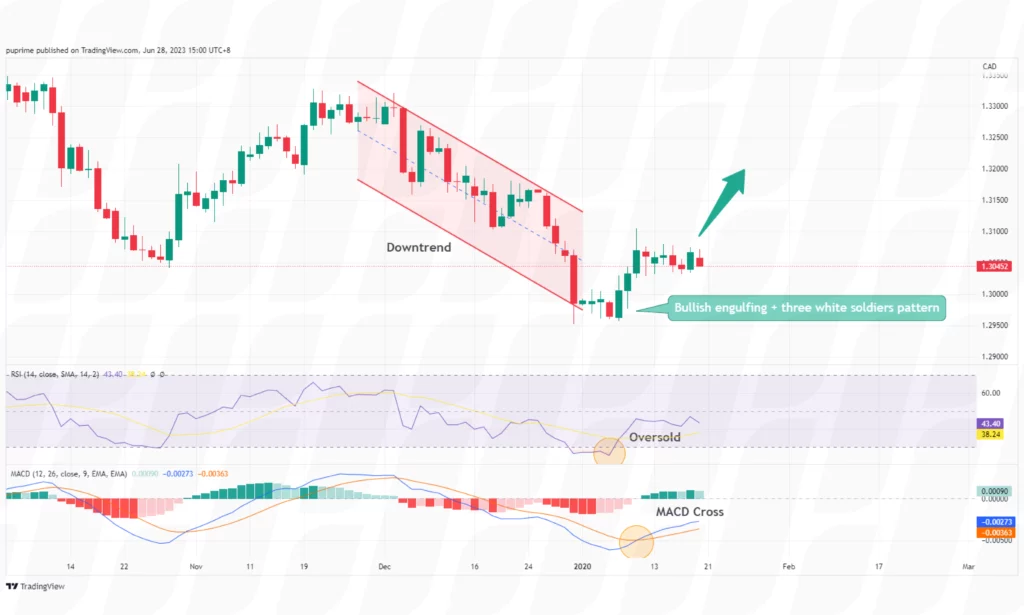
The Reversal trading strategy is a swing trading strategy that swing traders often use to identify potential trend reversals and capitalise on the subsequent price movements. Here’s how swing traders use reversal trading as one of their best swing trading strategies:
Identifying Reversal Signals: Swing traders look for specific price patterns or technical indicators that suggest a potential trend reversal. Common reversal patterns include double tops/bottoms, head and shoulders, or bullish/bearish engulfing patterns. These patterns indicate a shift in market sentiment and serve as potential entry signals for swing traders.
Confirming Reversal Signals: Once a potential reversal signal is identified, swing traders seek confirmation from the Relative Strength Index (RSI) or the Stochastic Oscillator, which indicates overbought or oversold conditions. Swing traders aim to enter trades at the early stages of a reversal, capturing the majority of the price movement. They often wait for a confirmation candlestick or a break of a key level to initiate the trade. Additionally, swing traders may use price targets based on the distance of the previous trend or significant support/resistance levels to determine where to exit the trade.
Monitoring Price Action and Volume: Swing traders closely monitor price action and volume during a potential reversal and look for signs of increased buying or selling pressure. Higher-than-average trading volume during a reversal can indicate strong market participation and increase the confidence in the trade setup.
Adjusting Targets and Timeframes: Swing traders adjust their profit targets and timeframes based on the potential strength of the reversal and market conditions. If a reversal signal suggests a significant trend change, swing traders may aim for larger profit targets and hold the position for a more extended period. Conversely, if the reversal is expected to be a shorter-term correction, swing traders may set smaller profit targets and exit the trade relatively quickly.
Adapting to Market Conditions:
Swing traders understand that not all reversal signals will result in successful trades. They remain flexible and adapt their strategies based on market conditions. If a reversal trade fails to materialize, swing traders may exit the trade quickly and reassess the market before considering new opportunities. They avoid becoming too attached to a particular trade idea and are willing to change their stance based on evolving market dynamics.
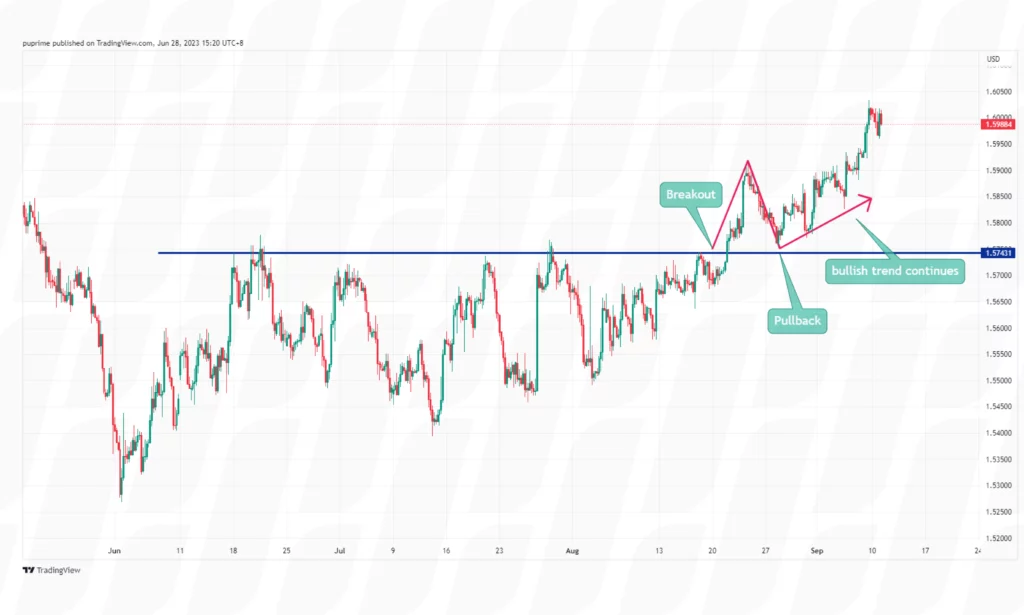
The pullback strategy focuses on trading within an established trend by capitalising on temporary price retracements. Pullback trading is a strategy that swing traders often employ to take advantage of temporary price retracements within an established trend. Here’s how swing traders use pullback trading to enhance their swing trading approach:
Identifying the Trend: Swing traders first identify the prevailing trend in the market, whether it is an uptrend or a downtrend. They analyze price charts, trendlines, moving averages, or other technical indicators to determine the direction and strength of the trend. This helps them understand the overall context in which they will be looking for pullback opportunities.
Spotting Pullback Opportunities: Once the trend is identified, swing traders search for pullback opportunities. A pullback occurs when the price temporarily retraces against the primary trend before resuming its direction. Swing traders look for areas where the price pulls back to a support level in an uptrend or a resistance level in a downtrend. These areas often provide attractive entry points for swing traders.
Confirming the Pullback: Similarly, to increase the probability of a successful trade, swing traders seek confirmation of the pullback using various technical indicators or tools to validate the strength of the primary trend and the potential for the pullback to reverse. Once a pullback is confirmed, swing traders set entry and exit criteria and typically enter the trade when the price shows signs of reversing and resuming the primary trend. This may involve waiting for a bullish or bearish candlestick pattern, a breakout above a specific level, or a bullish/bearish divergence on an oscillator.
Adapting to Changing Market Conditions: Once a pullback trade is entered, swing traders aim to capture the trend resumption. They seek to ride the price movement as it continues in the direction of the primary trend. However, swing traders understand that pullback trades may not always work out as expected. If a pullback fails to resume the primary trend or if market conditions change, a swing trader may choose to exit the trade quickly. Flexibility and the ability to adapt are essential traits of successful swing traders.
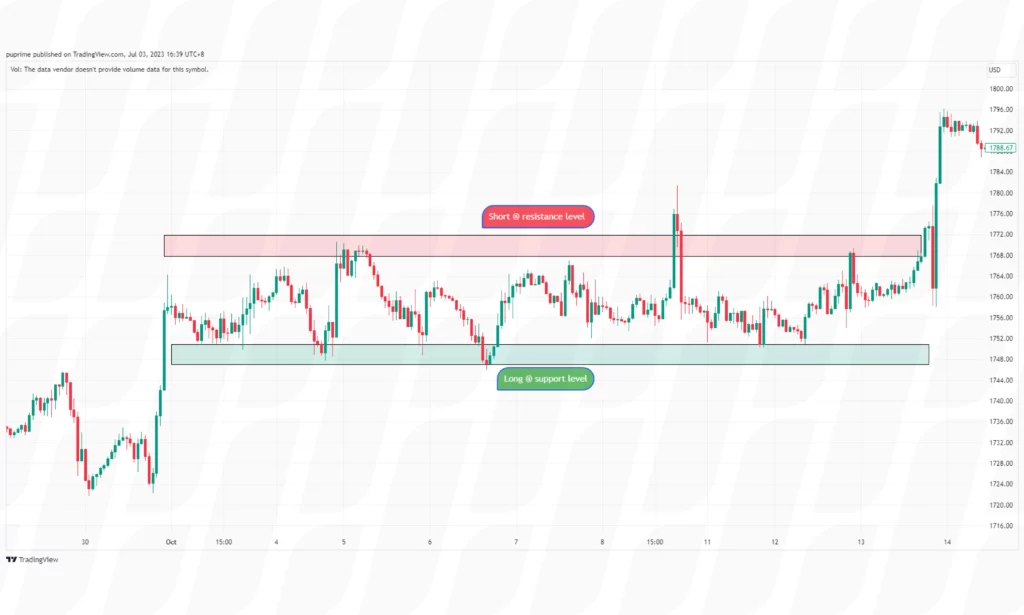
The range trading strategy involves identifying and trading within well-defined price ranges. Range trading is a strategy that swing traders often use to take advantage of price movements within a defined range or sideways market conditions. Here’s how swing traders use range trading for their best swing trading strategies:
Identifying Range-Bound Markets: Swing traders first identify periods of range-bound markets where the price is moving within a well-defined range, by observing horizontal support and resistance levels on the price chart with the use of technical indicators. One of the technical indicators often used are the Bollinger Bands, which can indicate periods of low volatility and price consolidation.
Setting and Entering Trades at Range Boundaries: Swing traders typically enter trades near the range boundaries. Swing traders establish profit targets and stop-loss levels based on the range boundaries and their risk tolerance. Profit targets are typically set near the opposing boundary of the range.
Monitoring Price Action and Range Breakouts: While the range trading strategy aims to capitalize on price movements within the established range, swing traders also monitor the price action closely for potential range breakouts. A range breakout occurs when the price decisively moves beyond the established boundaries, signaling a potential shift in market dynamics. Swing traders may choose to exit their range trades if a breakout occurs or adjust their strategies accordingly to take advantage of the new trend.
Adapting to Changing Market Conditions: Swing traders understand that market conditions can change, and ranges can evolve or break. They remain adaptable and flexible in their approach. If a range is no longer valid or if the price fails to respect the established boundaries, swing traders may exit their trades quickly or adjust their strategies based on evolving market dynamics.
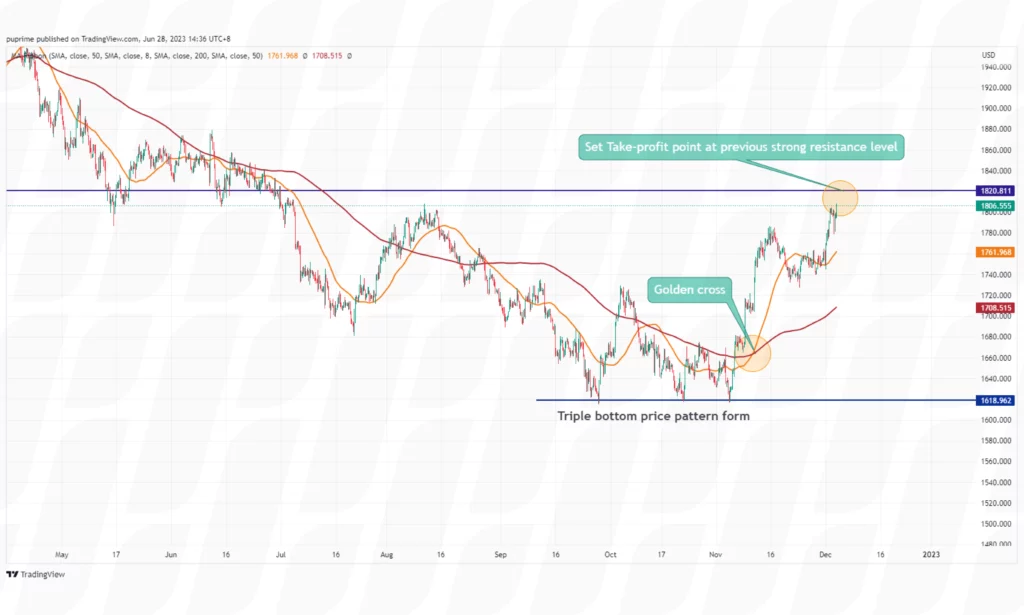
The moving average crossover strategy utilises two or more moving averages to generate trade signals. The moving average crossover trading strategy is a popular technique that swing traders use to identify potential entry and exit points in their swing trading strategies. Here’s how swing traders utilise the moving average crossover strategy to enhance their trading:
Selecting Moving Averages for the Trading Strategy: Swing traders typically choose two moving averages with different periods, such as a shorter-term moving average (e.g., 50-day) and a longer-term moving average (e.g., 200-day). The choice of moving averages depends on the trader’s preference and the timeframe they are trading.
Watch this video to understand in-depth about moving averages.
Identifying the Trend: The moving average crossover trading strategy helps swing traders identify the prevailing trend in the market. When the shorter-term moving average crosses above the longer-term moving average, it suggests a potential uptrend, and when the shorter-term moving average crosses below the longer-term moving average, it suggests a potential downtrend.
Entry Signals: Swing traders look for entry signals based on moving average crossovers. When the shorter-term moving average crosses above the longer-term moving average, it generates a bullish signal, indicating a potential entry point for a long position. Conversely, when the shorter-term moving average crosses below the longer-term moving average, it generates a bearish signal, indicating a potential entry point for a short position. While the moving average crossover provides a preliminary signal, swing traders would still seek confirmation from other technical indicators or chart patterns before entering a trade.
Setting Profit Targets: Swing traders set profit targets based on various factors, such as the distance between the moving averages or key support and resistance levels. They may also use trailing stops to lock in profits as the trade moves in their favor. Swing traders continuously monitor the moving average crossover to stay aware of potential changes in the trend. If the moving averages start to converge or the crossover fails to produce the desired results, swing traders may consider adjusting their strategies or exiting their positions to avoid prolonged losses.
Adapting to Market Conditions: Swing traders understand that market conditions can change, and trends can reverse. They remain adaptable and flexible in their approach. If the moving average crossover strategy no longer generates profitable trades, swing traders may seek alternative strategies or adjust their parameters based on the evolving market conditions.
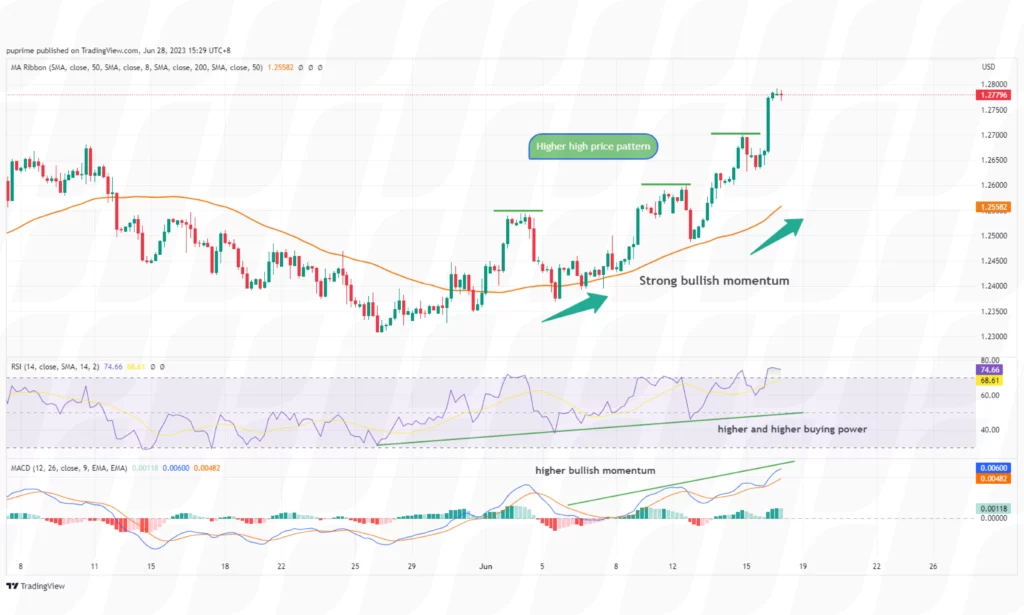
The momentum strategy involves trading based on the strength and velocity of price movements. Momentum trading is a trading strategy that swing traders often incorporate into their swing trading strategies to identify and capitalise on strong price movements. Here’s how swing traders use momentum trading strategies to enhance their swing trading approach:
Identifying Strong Price Movements: Swing traders focus on identifying assets or securities that are experiencing significant price movements or momentum. They analyse price charts and technical indicators to spot stocks or other financial instruments that are showing strong upward or downward momentum. The goal is to find assets that are likely to continue their price movement in the same direction, presenting potential trading opportunities.
Selecting Momentum Indicators: Swing traders use various technical indicators like RSI, MACD, or the Average Directional Index (ADX) to identify and confirm momentum in the market. Once strong momentum is identified, swing traders aim to time their entries and exits to maximise potential profits. They typically enter trades when the price confirms the momentum signal and shows a strong breakout or continuation pattern.
Monitoring Momentum Indicators: Swing traders continuously monitor momentum indicators to gauge the strength and sustainability of the price movement. This helps them make informed decisions about when to exit a trade or adjust their strategies. If momentum begins to weaken or shows signs of divergence from price action, swing traders may consider closing their positions to secure profits or limit potential losses.
Adapting to Changing Market Conditions: Swing traders understand that market conditions can change, and momentum can shift or dissipate. They remain adaptable and flexible in their approach. If momentum trading strategies are no longer generating profitable trades or if market conditions become unfavorable, swing traders may consider adjusting their strategies, exploring alternative trading techniques, or switching to different assets or markets.
Swing trading strategies have gained popularity among traders seeking to take advantage of shorter-term price movements in the financial markets. However, like any other trading strategies, swing trading strategies come with its own set of advantages and limitations that traders must consider. By understanding these factors, traders can make informed decisions and optimise their trading strategies to suit their individual goals and preferences.
Potential for Profits: Swing trading strategies can provide opportunities for significant profits by capturing short- to medium-term price swings. Traders can take advantage of both upward and downward movements in the market, potentially maximising their gains.
Flexibility: Swing trading allows for flexibility in terms of time commitment. Traders do not need to monitor the markets constantly like day traders do. They can set their trades, manage their positions, and analyse the markets at specific times during the day or week, making it suitable for those with other commitments.
Opportunity to Ride Trends: Swing traders can benefit from trends in the market by entering trades at favourable points within the trend. They aim to capture the bulk of a trend’s price movement, potentially maximising profits compared to day traders who exit positions within a single trading day.
Reduced Emotional Stress: Swing trading strategies typically involve holding positions for a few days to several weeks, reducing the pressure to constantly monitor every market tick. This can help traders avoid making impulsive decisions based on short-term market fluctuations, leading to more rational trading decisions.
Diverse Market Opportunities: Swing trading strategies can be applied to various financial markets, including stocks, currencies, commodities, and indices. This provides traders with a wide range of opportunities to explore and diversify their portfolios.

Market Volatility: Swing trading strategies can be challenging during periods of high market volatility. Sharp and sudden price movements can trigger stop-loss orders or result in missed profit targets. Traders must be prepared for increased market uncertainty and potential losses during volatile market conditions.
Overnight Risk: Swing traders hold positions overnight, which exposes them to overnight risk. Significant financial news, economic data releases, or geopolitical developments can occur while the markets are closed, potentially leading to price gaps and adverse market moves when trading resumes. Risk management in trading and the use of stop-loss orders are crucial to mitigate this risk.
Missed Opportunities: Swing traders rely on capturing intermediate price swings within a larger trend. However, if a trend reverses quickly or lacks significant price swings, swing traders may miss potential trading opportunities or end up with smaller profits. Adapting to changing market conditions and being vigilant in identifying suitable trade setups is essential.
Longer Holding Periods: Compared to day trading, swing trading involves holding positions for a longer duration. While this allows traders to potentially capture larger price movements, it also ties up capital for a longer period. Traders need to manage their capital effectively and ensure that they have sufficient funds available for other trading opportunities.
Emotional Discipline: Swing trading requires discipline and emotional control. Traders need to stick to their predefined trading plans, including entry and exit points, profit targets, and stop-loss levels. Emotional decision-making, such as holding onto losing positions or exiting winning trades prematurely, can significantly impact profitability.

Risk management in trading is a crucial aspect of swing trading strategies. While swing trading offers the potential for profits through capturing short- to medium-term price movements, it also exposes traders to market risks. Effectively managing these risks is essential for preserving capital and enhancing profitability.
Determining Risk Tolerance: Before engaging in swing trading, it’s crucial to determine your risk tolerance. This refers to the amount of capital you are willing to risk on each trade. Risk tolerance varies among individuals and is influenced by factors such as financial goals, investment experience, and personal circumstances. Understanding your risk tolerance helps you establish appropriate position sizes and set realistic expectations for potential gains and losses.
Setting Stop-Loss Orders: One of the most important risk management tools in swing trading is the use of stop-loss orders. A stop-loss order is a predetermined price level at which you will exit a trade to limit potential losses. By setting a stop-loss order, you define your risk per trade and protect yourself from excessive losses if the market moves against your position. It is essential to place stop-loss orders based on technical analysis or key support/resistance levels to ensure they are strategically positioned.
Using Trailing Stops: Trailing stops are an advanced risk management technique that allows you to protect profits while giving the trade room to move in your favour. With a trailing stop, the stop-loss order adjusts dynamically as the price moves in your favour. For example, if you set a trailing stop at 2% below the highest price reached, the stop-loss level will move up as the price rises, locking in profits if the price reverses. Trailing stops help protect gains and allow for potential further upside.
Employing Position Sizing: Position sizing refers to determining the appropriate amount of capital to allocate to each trade based on your risk tolerance. It involves considering the distance between your entry price and stop-loss level to calculate the position size. Proper position sizing ensures that you are not risking too much of your capital on a single trade, helping to safeguard against significant losses. Risking a fixed percentage of your trading capital, such as 1-2%, on each trade is a common approach for position sizing.
Diversifying Your Portfolio: Diversification is a risk management strategy that involves spreading your capital across different trades and assets. By diversifying your portfolio, you reduce the impact of a single trade’s outcome on your overall capital. Allocate your capital to various financial markets, sectors, or trading strategies to minimise exposure to any single event or risk factor. Diversification can help mitigate the impact of unfavourable market conditions on your trading performance.
Managing Leverage: Leverage can amplify both profits and losses in swing trading. While leveraged trading can enhance potential gains, it also increases the risk of significant losses. It is important to use leverage judiciously and understand the associated risks. Consider the leverage ratio provided by your broker and adjust your position size accordingly. Keep in mind that higher leverage in leveraged trading also requires stricter risk management in trading and careful monitoring of trades.

In conclusion, swing trading strategies provide traders with a dynamic and versatile approach to navigating the financial markets. By capitalising on shorter-term price movements within broader trends, swing traders aim to capture profits in a relatively short period. While a swing trading strategy offers potential advantages, it is important to recognize the limitations and challenges involved. Swing traders must remain vigilant, continually refine their trading strategies, and stay disciplined in their decision-making to navigate the complexities of a swing trading strategy effectively. With a solid understanding of swing trading strategies and careful execution, swing traders can enhance their chances of achieving long-term success in the financial markets.

Trade forex, indices, metal, and more at industry-low spreads and lightning-fast execution.
Sign up for a PU Prime Live Account with our hassle-free process.
Effortlessly fund your account with a wide range of channels and accepted currencies.
Access hundreds of instruments under market-leading trading conditions.
Please note the Website is intended for individuals residing in jurisdictions where accessing the Website is permitted by law.
Please note that PU Prime and its affiliated entities are neither established nor operating in your home jurisdiction.
By clicking the "Acknowledge" button, you confirm that you are entering this website solely based on your initiative and not as a result of any specific marketing outreach. You wish to obtain information from this website which is provided on reverse solicitation in accordance with the laws of your home jurisdiction.
Thank You for Your Acknowledgement!
Ten en cuenta que el sitio web está destinado a personas que residen en jurisdicciones donde el acceso al sitio web está permitido por la ley.
Ten en cuenta que PU Prime y sus entidades afiliadas no están establecidas ni operan en tu jurisdicción de origen.
Al hacer clic en el botón "Aceptar", confirmas que estás ingresando a este sitio web por tu propia iniciativa y no como resultado de ningún esfuerzo de marketing específico. Deseas obtener información de este sitio web que se proporciona mediante solicitud inversa de acuerdo con las leyes de tu jurisdicción de origen.
Thank You for Your Acknowledgement!